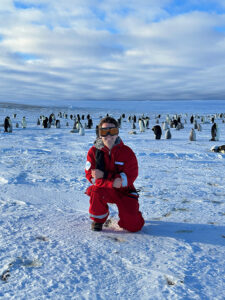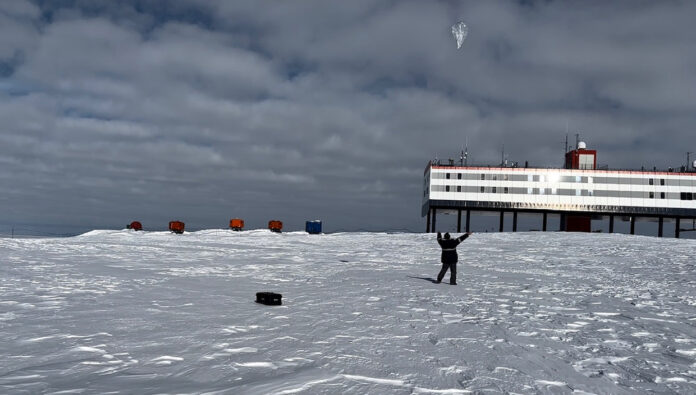HUNTSVILLE – As an amateur radio enthusiast, Todd McKinney could be seen launching balloon experiments outside his dorm room during his undergraduate days at the University of Alabama in Huntsville.
Now a first-year Atmospheric and Earth Sciences (AES) graduate student, McKinney has transformed his hobby into a low-cost, meteorological tool to study how air parcels travel within the upper troposphere and lower stratosphere in Antarctica. Real-time data collected by McKinney’s balloon experiment could help validate weather model outputs that forecast the track of air parcels in the atmosphere.
“Super-pressure balloons are unique; instead of rising and bursting like regular balloons, they achieve a stable float altitude,” said McKinney. This allows super-pressure balloons to travel very far distances while remaining aloft for multiple days or even months at a time.”

Neumayer Station III in Antarctica.
(Courtesy: Todd McKinney)
Made from materials costing well below $100, McKinney’s balloons could change the future of super-pressure balloon experiments by providing a smaller, more cost-effective solution for future Antarctica super-pressure balloon flights.
Larger super-pressure balloons primarily operated by NASA and other government agencies necessitate a significant number of resources and infrastructure to launch and sustain. Through funding by UAH’s Space Hardware Club, McKinney first launched his micro super-pressure balloons at UAH. After successful launches where McKinney’s balloons remained aloft for several months in the Northern Hemisphere, he applied for station time at the Alfred-Wegener Institut Neumayer Station III to test his balloons in the harsh Antarctic environment.
With his station time approved and support from his UAH AES advisor Dr. Mike Newchurch, McKinney traveled to Antarctica via funding by UAH’s College of Science, Department of Atmospheric and Earth Sciences, Earth System Science Center, and the Alabama Space Grant Consortium with the Space Hardware Club. Battling harsh winds and frigid temperatures, McKinney launched eight micro super-pressure balloons from Neumayer Station III in Antarctica between November and December 2022.
As of February, three of McKinney’s micro super-pressure balloons remain aloft. To track and collect data, he attached a radio tracker to each balloon. The radio tracker transmits the balloon’s location, solar voltage and temperature on a special 20-meter band which propagates off the ionosphere and is picked up by radio stations across the world. This type of data collection can aid in validating models of solar activity and its effects on radio propagation in the southern hemisphere.
After Antarctica summer concludes, McKinney will publish reports on the performance of
the balloon and their collected data. Ultimately, he said his balloon-based research
will contribute to the development of more cost-effective and compact methods for
atmospheric and ionospheric profiling and will support research in earth sciences and
heliophysics.
Don’t miss out! Subscribe to our email newsletter to have all our smart stories delivered to your inbox.



